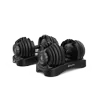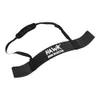New study reveals that getting stronger requires fewer sets than you think

If your idea of a successful workout is cranking out endless sets to failure, then a new meta-analysis on optimal training volume (via Men's Health) should provide a welcome reprieve.
The study, which has yet to be peer-reviewed, suggests you may only need as little as 11 total sets per muscle group in a single session to see the best results for muscle growth. Anything more than that and you're entering the world of diminishing returns.
According to the research (which analyzed 2,000 people across 67 studies) when it comes to actual strength gain, the amount required is even lower. The conclusion is that most people will only need two direct sets per muscle group to see improvements in their strength.
The conclusion is that most people will only need two direct sets per muscle group to see improvements in their strength.
That means, in theory, that you only need to find time for two heavy squat sets in a session to start seeing short-to-medium term benefits.
Of course, if you want to start programming in more than two sets you're going to see muscle gains but, the study suggests, beyond around 11 sets (think glute bridges, calf raises or leg presses on leg day) your muscles' ability to grow is going to plateau.
Here's how the study puts it in science speak: "Both best fit models suggest diminishing returns as per-session set volume increases, with the PUOS [Point of Upper Satiation] occurring at ~2 ‘direct’ sets for strength and ~11 ‘fractional’ sets for hypertrophy.
"Notably, the ‘direct’ set model for strength gains suggests more strongly diminishing returns compared to the ‘fractional’ set model for hypertrophy."
Get instant access to breaking news, the hottest reviews, great deals and helpful tips.
If you need a refresher, a direct set is a move specifically targeting a muscle group while an indirect or fractional set means something like a chin-up that hits lats, biceps, shoulders and other tangential muscles.
The study was conducted by a team of researchers from Florida Atlantic University and distributed by The Society for Transparency, Openness, and Replication in Kinesiology (STORK). If you've not heard of it (I hadn't), it STORK "provides a platform for kinesiologists, movement scientists, sport and exercise scientists, physical activity and health scientists to come together to improve methods and practices within our respective disciplines."
What this means for you

Everyone's training routine will differ based on what they're trying to accomplish, but it might be worth testing the findings of this meta-study out for yourself.
Where it will come in particularly useful is for time-poor exercisers. If you're trying to juggle a full-time job, childcare, social commitments, or obligations, or any other demands, it's nice to know you don't need endless sets for your body to respond.
Training for optimal set volume could be something you try during your next few gym or home workout sessions. Just make sure you're holding true to progressive overload as you do so.
More from Tom's Guide
- High reps vs heavy weights: which is better for building muscle?
- Hypertrophy vs strength training: Which is better for building muscle?
- I’ve been teaching weightlifting for years — 3 ways to build strength and muscle using light weights

Jeff is UK Editor-in-Chief for Tom’s Guide looking after the day-to-day output of the site’s British contingent.
A tech journalist for over a decade, he’s travelled the world testing any gadget he can get his hands on. Jeff has a keen interest in fitness and wearables as well as the latest tablets and laptops.
A lapsed gamer, he fondly remembers the days when technical problems were solved by taking out the cartridge and blowing out the dust.
You must confirm your public display name before commenting
Please logout and then login again, you will then be prompted to enter your display name.










